Developing Cultural Competence: Working with Indigenous Communities
VerifiedAdded on 2022/10/12
|8
|2190
|31
Essay
AI Summary
This essay explores the critical concept of cultural competence within the context of early childhood education, with a specific focus on working with Indigenous Australian children and families. It defines cultural competence and emphasizes the importance of educators overcoming their own biases and preconceptions to create a culturally safe and inclusive environment. The paper addresses key questions such as how to establish a culturally safe setting, the importance of staff consultation with cultural groups, strategies for promoting participation, the benefits of family involvement in sharing their context and cultural knowledge, and methods for fostering inclusion and embracing diversity. It also highlights the significance of modeling open, ethical interactions and providing additional cultural support when necessary. The essay underscores the need for cultural assimilation to build trust within the indigenous communities and foster integration within the mainstream society.
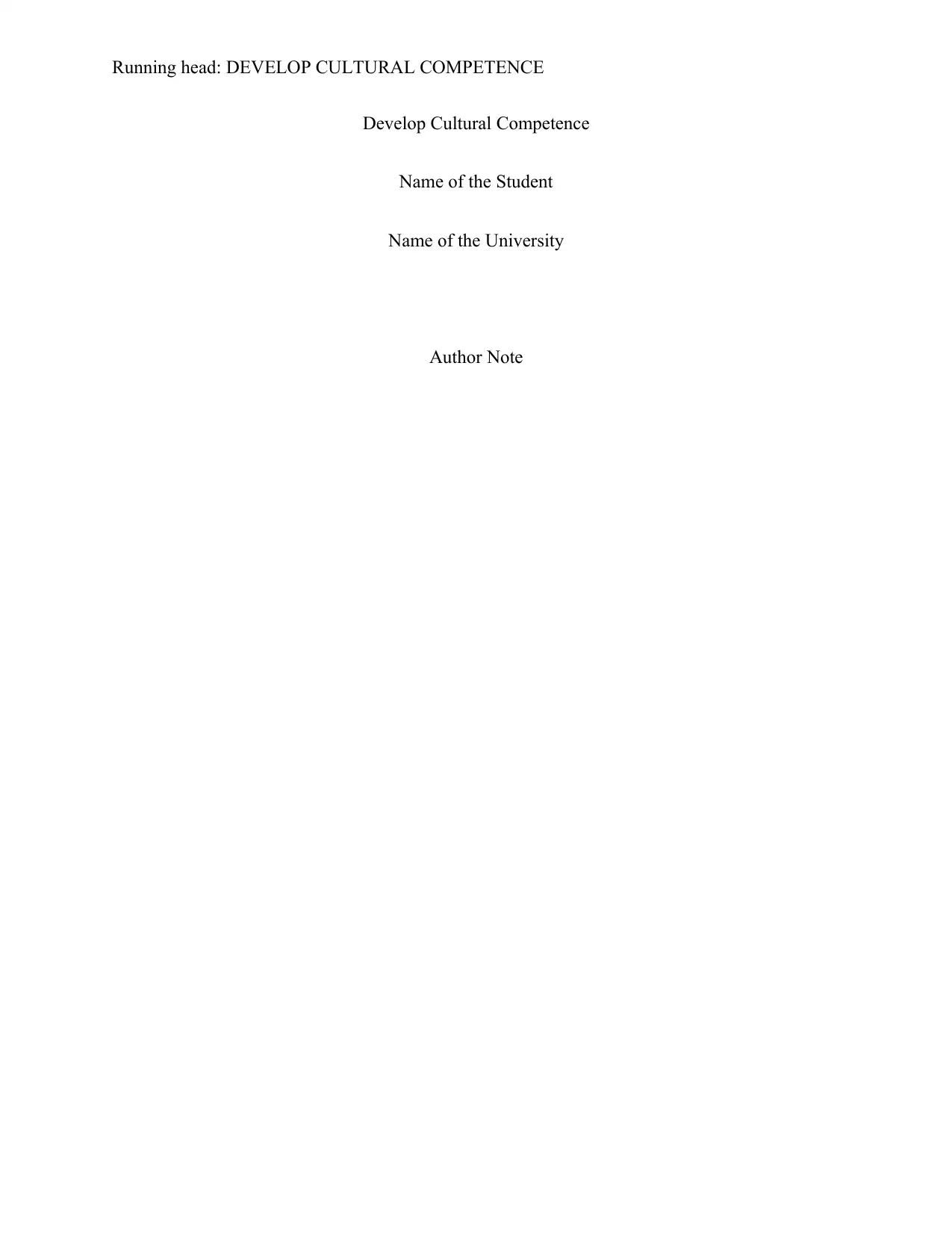
Running head: DEVELOP CULTURAL COMPETENCE
Develop Cultural Competence
Name of the Student
Name of the University
Author Note
Develop Cultural Competence
Name of the Student
Name of the University
Author Note
Paraphrase This Document
Need a fresh take? Get an instant paraphrase of this document with our AI Paraphraser
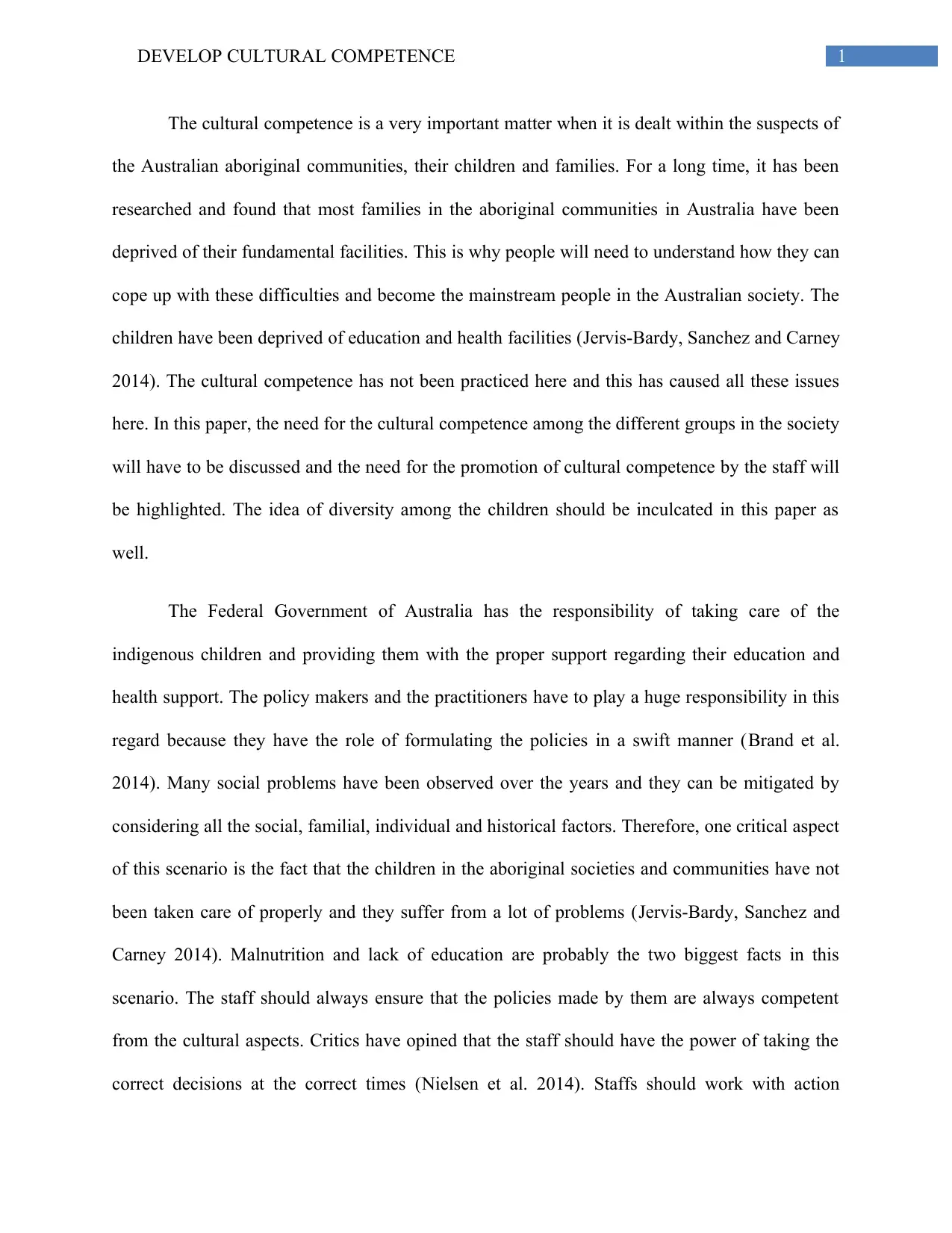
1DEVELOP CULTURAL COMPETENCE
The cultural competence is a very important matter when it is dealt within the suspects of
the Australian aboriginal communities, their children and families. For a long time, it has been
researched and found that most families in the aboriginal communities in Australia have been
deprived of their fundamental facilities. This is why people will need to understand how they can
cope up with these difficulties and become the mainstream people in the Australian society. The
children have been deprived of education and health facilities (Jervis-Bardy, Sanchez and Carney
2014). The cultural competence has not been practiced here and this has caused all these issues
here. In this paper, the need for the cultural competence among the different groups in the society
will have to be discussed and the need for the promotion of cultural competence by the staff will
be highlighted. The idea of diversity among the children should be inculcated in this paper as
well.
The Federal Government of Australia has the responsibility of taking care of the
indigenous children and providing them with the proper support regarding their education and
health support. The policy makers and the practitioners have to play a huge responsibility in this
regard because they have the role of formulating the policies in a swift manner (Brand et al.
2014). Many social problems have been observed over the years and they can be mitigated by
considering all the social, familial, individual and historical factors. Therefore, one critical aspect
of this scenario is the fact that the children in the aboriginal societies and communities have not
been taken care of properly and they suffer from a lot of problems (Jervis-Bardy, Sanchez and
Carney 2014). Malnutrition and lack of education are probably the two biggest facts in this
scenario. The staff should always ensure that the policies made by them are always competent
from the cultural aspects. Critics have opined that the staff should have the power of taking the
correct decisions at the correct times (Nielsen et al. 2014). Staffs should work with action
The cultural competence is a very important matter when it is dealt within the suspects of
the Australian aboriginal communities, their children and families. For a long time, it has been
researched and found that most families in the aboriginal communities in Australia have been
deprived of their fundamental facilities. This is why people will need to understand how they can
cope up with these difficulties and become the mainstream people in the Australian society. The
children have been deprived of education and health facilities (Jervis-Bardy, Sanchez and Carney
2014). The cultural competence has not been practiced here and this has caused all these issues
here. In this paper, the need for the cultural competence among the different groups in the society
will have to be discussed and the need for the promotion of cultural competence by the staff will
be highlighted. The idea of diversity among the children should be inculcated in this paper as
well.
The Federal Government of Australia has the responsibility of taking care of the
indigenous children and providing them with the proper support regarding their education and
health support. The policy makers and the practitioners have to play a huge responsibility in this
regard because they have the role of formulating the policies in a swift manner (Brand et al.
2014). Many social problems have been observed over the years and they can be mitigated by
considering all the social, familial, individual and historical factors. Therefore, one critical aspect
of this scenario is the fact that the children in the aboriginal societies and communities have not
been taken care of properly and they suffer from a lot of problems (Jervis-Bardy, Sanchez and
Carney 2014). Malnutrition and lack of education are probably the two biggest facts in this
scenario. The staff should always ensure that the policies made by them are always competent
from the cultural aspects. Critics have opined that the staff should have the power of taking the
correct decisions at the correct times (Nielsen et al. 2014). Staffs should work with action
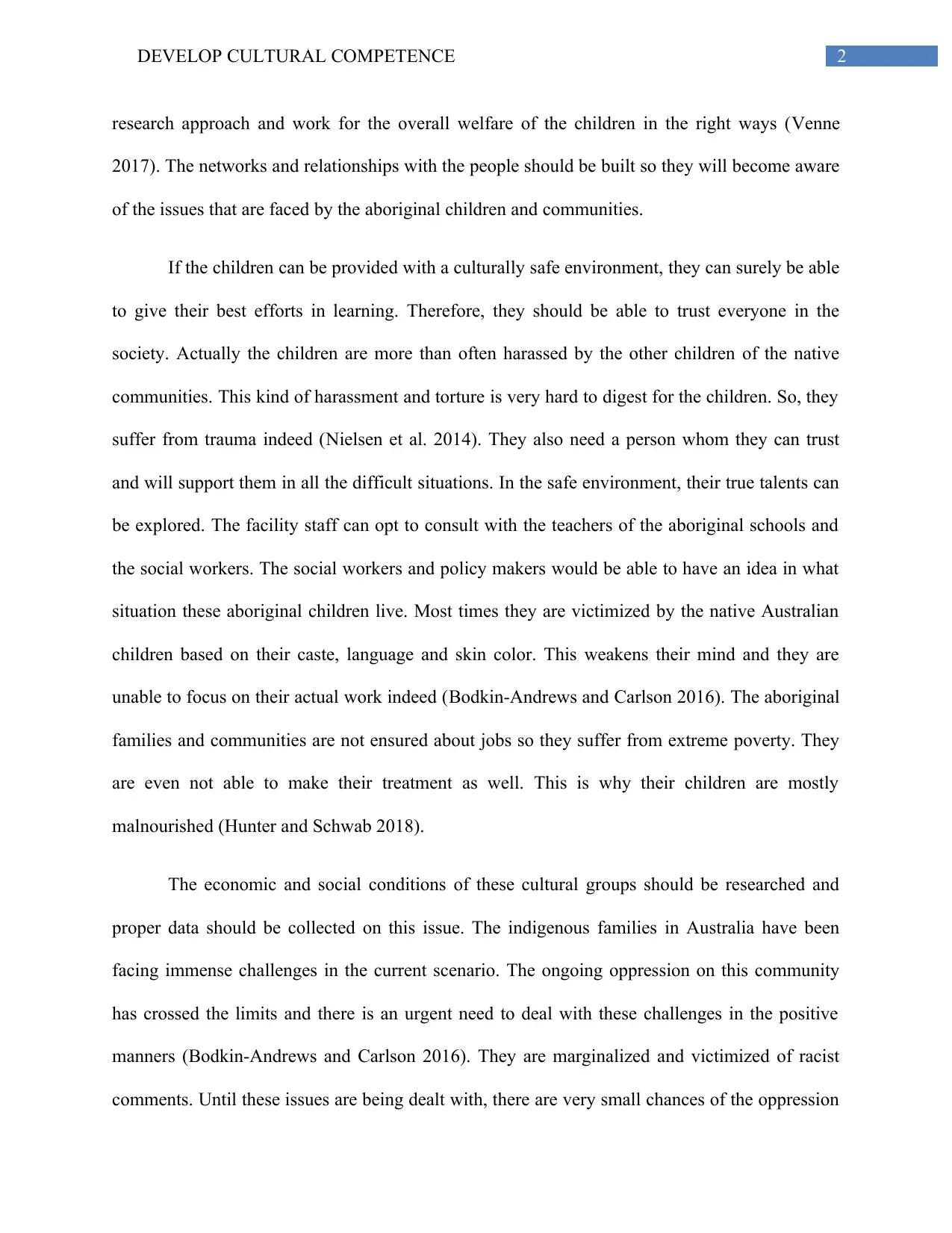
2DEVELOP CULTURAL COMPETENCE
research approach and work for the overall welfare of the children in the right ways (Venne
2017). The networks and relationships with the people should be built so they will become aware
of the issues that are faced by the aboriginal children and communities.
If the children can be provided with a culturally safe environment, they can surely be able
to give their best efforts in learning. Therefore, they should be able to trust everyone in the
society. Actually the children are more than often harassed by the other children of the native
communities. This kind of harassment and torture is very hard to digest for the children. So, they
suffer from trauma indeed (Nielsen et al. 2014). They also need a person whom they can trust
and will support them in all the difficult situations. In the safe environment, their true talents can
be explored. The facility staff can opt to consult with the teachers of the aboriginal schools and
the social workers. The social workers and policy makers would be able to have an idea in what
situation these aboriginal children live. Most times they are victimized by the native Australian
children based on their caste, language and skin color. This weakens their mind and they are
unable to focus on their actual work indeed (Bodkin-Andrews and Carlson 2016). The aboriginal
families and communities are not ensured about jobs so they suffer from extreme poverty. They
are even not able to make their treatment as well. This is why their children are mostly
malnourished (Hunter and Schwab 2018).
The economic and social conditions of these cultural groups should be researched and
proper data should be collected on this issue. The indigenous families in Australia have been
facing immense challenges in the current scenario. The ongoing oppression on this community
has crossed the limits and there is an urgent need to deal with these challenges in the positive
manners (Bodkin-Andrews and Carlson 2016). They are marginalized and victimized of racist
comments. Until these issues are being dealt with, there are very small chances of the oppression
research approach and work for the overall welfare of the children in the right ways (Venne
2017). The networks and relationships with the people should be built so they will become aware
of the issues that are faced by the aboriginal children and communities.
If the children can be provided with a culturally safe environment, they can surely be able
to give their best efforts in learning. Therefore, they should be able to trust everyone in the
society. Actually the children are more than often harassed by the other children of the native
communities. This kind of harassment and torture is very hard to digest for the children. So, they
suffer from trauma indeed (Nielsen et al. 2014). They also need a person whom they can trust
and will support them in all the difficult situations. In the safe environment, their true talents can
be explored. The facility staff can opt to consult with the teachers of the aboriginal schools and
the social workers. The social workers and policy makers would be able to have an idea in what
situation these aboriginal children live. Most times they are victimized by the native Australian
children based on their caste, language and skin color. This weakens their mind and they are
unable to focus on their actual work indeed (Bodkin-Andrews and Carlson 2016). The aboriginal
families and communities are not ensured about jobs so they suffer from extreme poverty. They
are even not able to make their treatment as well. This is why their children are mostly
malnourished (Hunter and Schwab 2018).
The economic and social conditions of these cultural groups should be researched and
proper data should be collected on this issue. The indigenous families in Australia have been
facing immense challenges in the current scenario. The ongoing oppression on this community
has crossed the limits and there is an urgent need to deal with these challenges in the positive
manners (Bodkin-Andrews and Carlson 2016). They are marginalized and victimized of racist
comments. Until these issues are being dealt with, there are very small chances of the oppression
⊘ This is a preview!⊘
Do you want full access?
Subscribe today to unlock all pages.

Trusted by 1+ million students worldwide
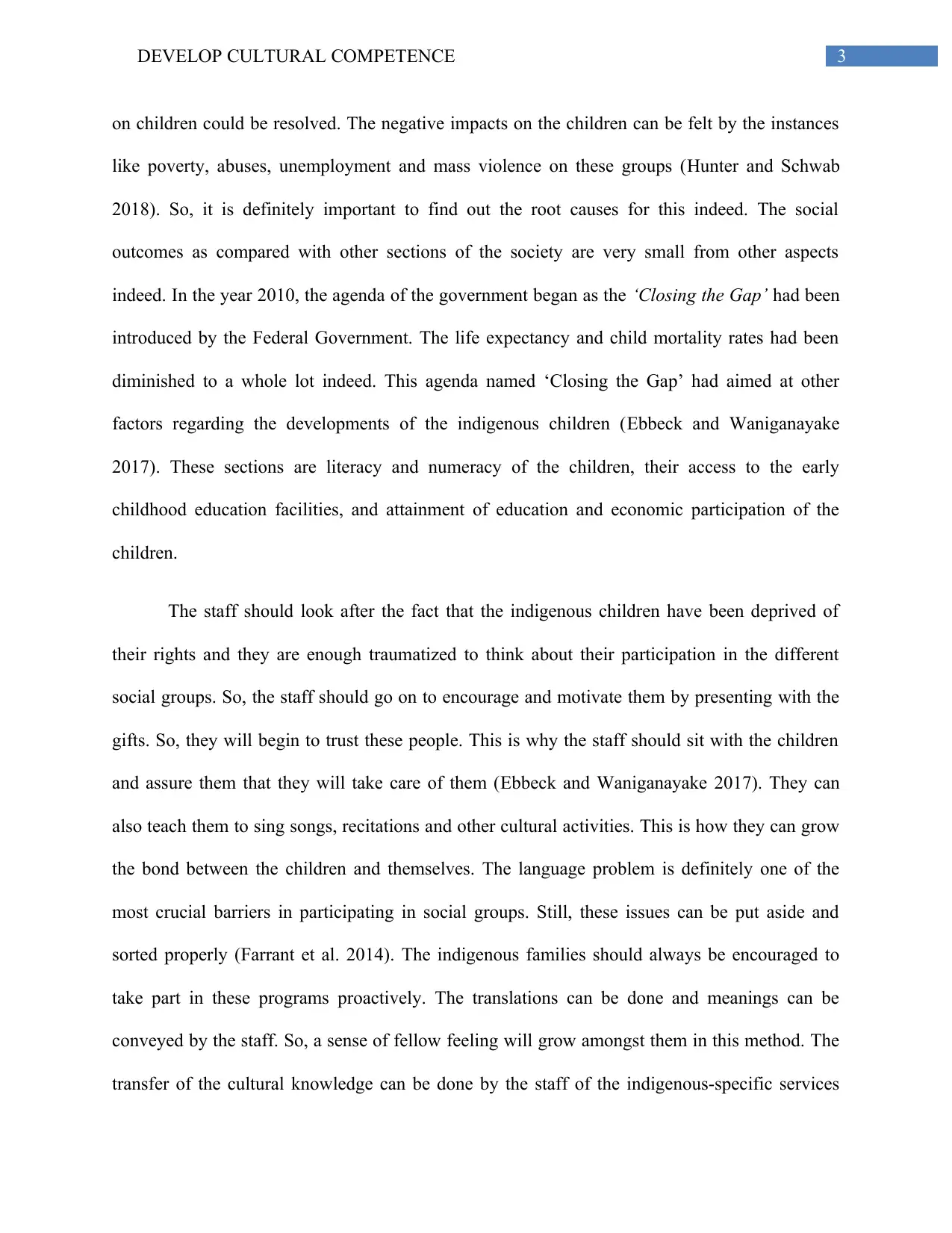
3DEVELOP CULTURAL COMPETENCE
on children could be resolved. The negative impacts on the children can be felt by the instances
like poverty, abuses, unemployment and mass violence on these groups (Hunter and Schwab
2018). So, it is definitely important to find out the root causes for this indeed. The social
outcomes as compared with other sections of the society are very small from other aspects
indeed. In the year 2010, the agenda of the government began as the ‘Closing the Gap’ had been
introduced by the Federal Government. The life expectancy and child mortality rates had been
diminished to a whole lot indeed. This agenda named ‘Closing the Gap’ had aimed at other
factors regarding the developments of the indigenous children (Ebbeck and Waniganayake
2017). These sections are literacy and numeracy of the children, their access to the early
childhood education facilities, and attainment of education and economic participation of the
children.
The staff should look after the fact that the indigenous children have been deprived of
their rights and they are enough traumatized to think about their participation in the different
social groups. So, the staff should go on to encourage and motivate them by presenting with the
gifts. So, they will begin to trust these people. This is why the staff should sit with the children
and assure them that they will take care of them (Ebbeck and Waniganayake 2017). They can
also teach them to sing songs, recitations and other cultural activities. This is how they can grow
the bond between the children and themselves. The language problem is definitely one of the
most crucial barriers in participating in social groups. Still, these issues can be put aside and
sorted properly (Farrant et al. 2014). The indigenous families should always be encouraged to
take part in these programs proactively. The translations can be done and meanings can be
conveyed by the staff. So, a sense of fellow feeling will grow amongst them in this method. The
transfer of the cultural knowledge can be done by the staff of the indigenous-specific services
on children could be resolved. The negative impacts on the children can be felt by the instances
like poverty, abuses, unemployment and mass violence on these groups (Hunter and Schwab
2018). So, it is definitely important to find out the root causes for this indeed. The social
outcomes as compared with other sections of the society are very small from other aspects
indeed. In the year 2010, the agenda of the government began as the ‘Closing the Gap’ had been
introduced by the Federal Government. The life expectancy and child mortality rates had been
diminished to a whole lot indeed. This agenda named ‘Closing the Gap’ had aimed at other
factors regarding the developments of the indigenous children (Ebbeck and Waniganayake
2017). These sections are literacy and numeracy of the children, their access to the early
childhood education facilities, and attainment of education and economic participation of the
children.
The staff should look after the fact that the indigenous children have been deprived of
their rights and they are enough traumatized to think about their participation in the different
social groups. So, the staff should go on to encourage and motivate them by presenting with the
gifts. So, they will begin to trust these people. This is why the staff should sit with the children
and assure them that they will take care of them (Ebbeck and Waniganayake 2017). They can
also teach them to sing songs, recitations and other cultural activities. This is how they can grow
the bond between the children and themselves. The language problem is definitely one of the
most crucial barriers in participating in social groups. Still, these issues can be put aside and
sorted properly (Farrant et al. 2014). The indigenous families should always be encouraged to
take part in these programs proactively. The translations can be done and meanings can be
conveyed by the staff. So, a sense of fellow feeling will grow amongst them in this method. The
transfer of the cultural knowledge can be done by the staff of the indigenous-specific services
Paraphrase This Document
Need a fresh take? Get an instant paraphrase of this document with our AI Paraphraser
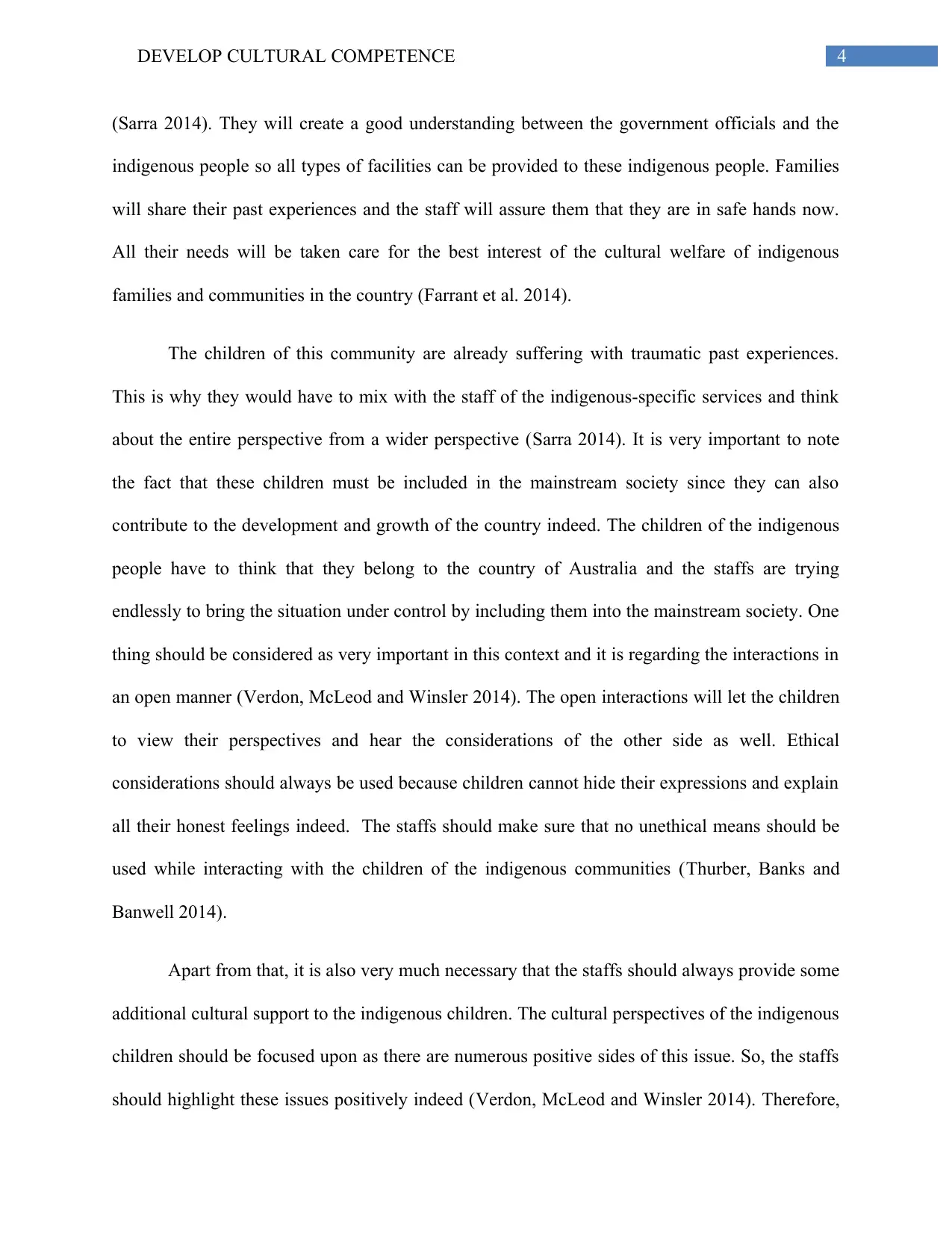
4DEVELOP CULTURAL COMPETENCE
(Sarra 2014). They will create a good understanding between the government officials and the
indigenous people so all types of facilities can be provided to these indigenous people. Families
will share their past experiences and the staff will assure them that they are in safe hands now.
All their needs will be taken care for the best interest of the cultural welfare of indigenous
families and communities in the country (Farrant et al. 2014).
The children of this community are already suffering with traumatic past experiences.
This is why they would have to mix with the staff of the indigenous-specific services and think
about the entire perspective from a wider perspective (Sarra 2014). It is very important to note
the fact that these children must be included in the mainstream society since they can also
contribute to the development and growth of the country indeed. The children of the indigenous
people have to think that they belong to the country of Australia and the staffs are trying
endlessly to bring the situation under control by including them into the mainstream society. One
thing should be considered as very important in this context and it is regarding the interactions in
an open manner (Verdon, McLeod and Winsler 2014). The open interactions will let the children
to view their perspectives and hear the considerations of the other side as well. Ethical
considerations should always be used because children cannot hide their expressions and explain
all their honest feelings indeed. The staffs should make sure that no unethical means should be
used while interacting with the children of the indigenous communities (Thurber, Banks and
Banwell 2014).
Apart from that, it is also very much necessary that the staffs should always provide some
additional cultural support to the indigenous children. The cultural perspectives of the indigenous
children should be focused upon as there are numerous positive sides of this issue. So, the staffs
should highlight these issues positively indeed (Verdon, McLeod and Winsler 2014). Therefore,
(Sarra 2014). They will create a good understanding between the government officials and the
indigenous people so all types of facilities can be provided to these indigenous people. Families
will share their past experiences and the staff will assure them that they are in safe hands now.
All their needs will be taken care for the best interest of the cultural welfare of indigenous
families and communities in the country (Farrant et al. 2014).
The children of this community are already suffering with traumatic past experiences.
This is why they would have to mix with the staff of the indigenous-specific services and think
about the entire perspective from a wider perspective (Sarra 2014). It is very important to note
the fact that these children must be included in the mainstream society since they can also
contribute to the development and growth of the country indeed. The children of the indigenous
people have to think that they belong to the country of Australia and the staffs are trying
endlessly to bring the situation under control by including them into the mainstream society. One
thing should be considered as very important in this context and it is regarding the interactions in
an open manner (Verdon, McLeod and Winsler 2014). The open interactions will let the children
to view their perspectives and hear the considerations of the other side as well. Ethical
considerations should always be used because children cannot hide their expressions and explain
all their honest feelings indeed. The staffs should make sure that no unethical means should be
used while interacting with the children of the indigenous communities (Thurber, Banks and
Banwell 2014).
Apart from that, it is also very much necessary that the staffs should always provide some
additional cultural support to the indigenous children. The cultural perspectives of the indigenous
children should be focused upon as there are numerous positive sides of this issue. So, the staffs
should highlight these issues positively indeed (Verdon, McLeod and Winsler 2014). Therefore,
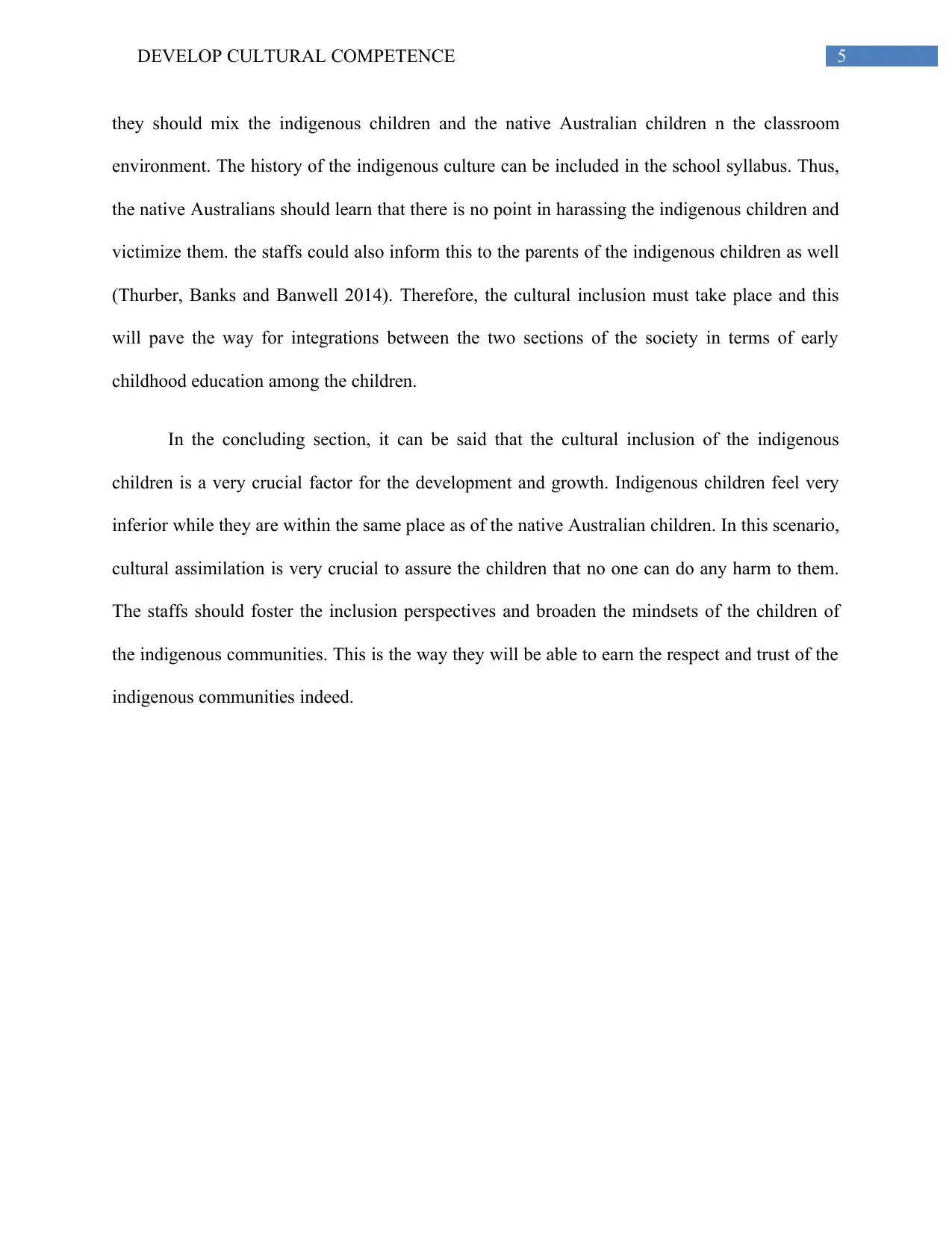
5DEVELOP CULTURAL COMPETENCE
they should mix the indigenous children and the native Australian children n the classroom
environment. The history of the indigenous culture can be included in the school syllabus. Thus,
the native Australians should learn that there is no point in harassing the indigenous children and
victimize them. the staffs could also inform this to the parents of the indigenous children as well
(Thurber, Banks and Banwell 2014). Therefore, the cultural inclusion must take place and this
will pave the way for integrations between the two sections of the society in terms of early
childhood education among the children.
In the concluding section, it can be said that the cultural inclusion of the indigenous
children is a very crucial factor for the development and growth. Indigenous children feel very
inferior while they are within the same place as of the native Australian children. In this scenario,
cultural assimilation is very crucial to assure the children that no one can do any harm to them.
The staffs should foster the inclusion perspectives and broaden the mindsets of the children of
the indigenous communities. This is the way they will be able to earn the respect and trust of the
indigenous communities indeed.
they should mix the indigenous children and the native Australian children n the classroom
environment. The history of the indigenous culture can be included in the school syllabus. Thus,
the native Australians should learn that there is no point in harassing the indigenous children and
victimize them. the staffs could also inform this to the parents of the indigenous children as well
(Thurber, Banks and Banwell 2014). Therefore, the cultural inclusion must take place and this
will pave the way for integrations between the two sections of the society in terms of early
childhood education among the children.
In the concluding section, it can be said that the cultural inclusion of the indigenous
children is a very crucial factor for the development and growth. Indigenous children feel very
inferior while they are within the same place as of the native Australian children. In this scenario,
cultural assimilation is very crucial to assure the children that no one can do any harm to them.
The staffs should foster the inclusion perspectives and broaden the mindsets of the children of
the indigenous communities. This is the way they will be able to earn the respect and trust of the
indigenous communities indeed.
⊘ This is a preview!⊘
Do you want full access?
Subscribe today to unlock all pages.

Trusted by 1+ million students worldwide
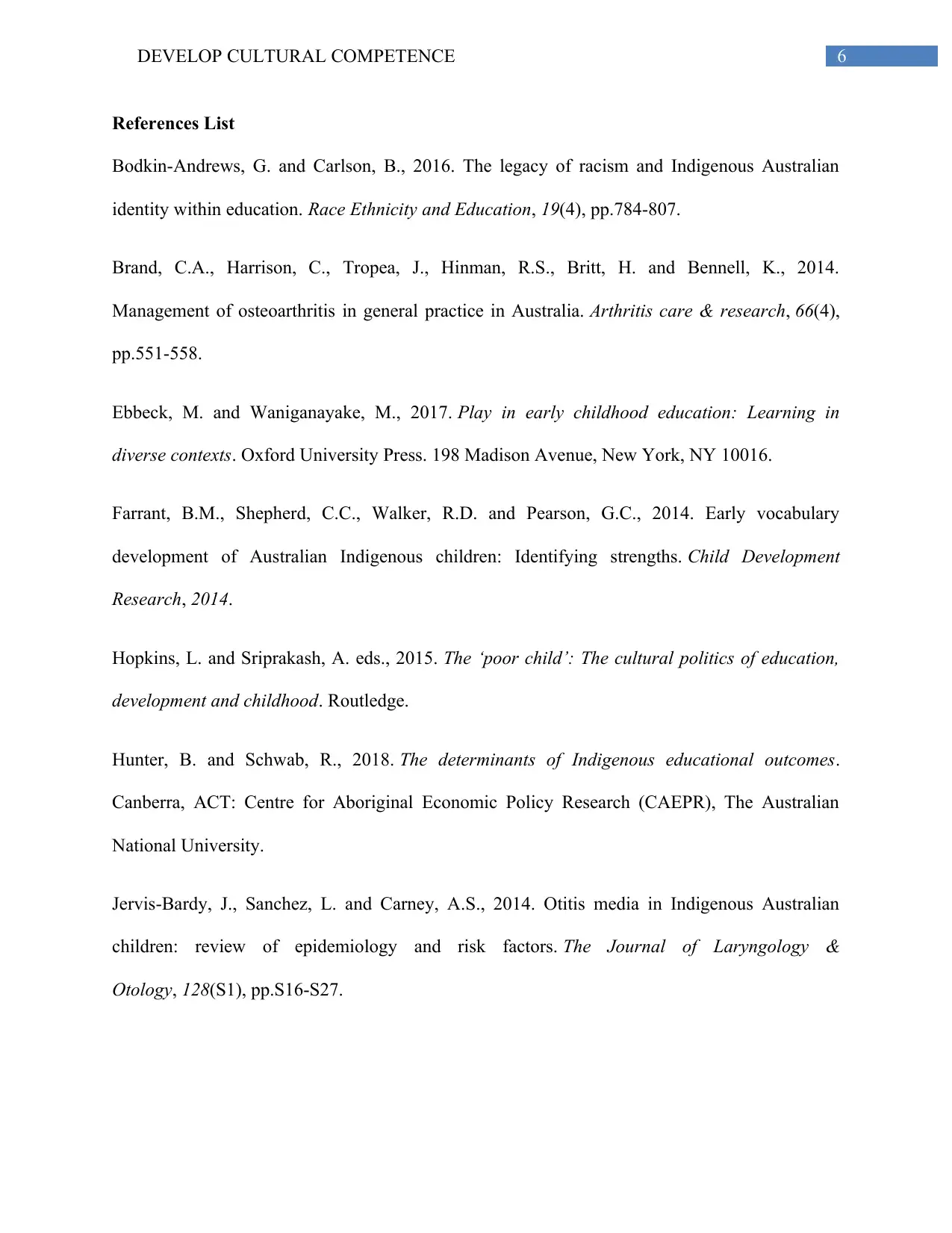
6DEVELOP CULTURAL COMPETENCE
References List
Bodkin-Andrews, G. and Carlson, B., 2016. The legacy of racism and Indigenous Australian
identity within education. Race Ethnicity and Education, 19(4), pp.784-807.
Brand, C.A., Harrison, C., Tropea, J., Hinman, R.S., Britt, H. and Bennell, K., 2014.
Management of osteoarthritis in general practice in Australia. Arthritis care & research, 66(4),
pp.551-558.
Ebbeck, M. and Waniganayake, M., 2017. Play in early childhood education: Learning in
diverse contexts. Oxford University Press. 198 Madison Avenue, New York, NY 10016.
Farrant, B.M., Shepherd, C.C., Walker, R.D. and Pearson, G.C., 2014. Early vocabulary
development of Australian Indigenous children: Identifying strengths. Child Development
Research, 2014.
Hopkins, L. and Sriprakash, A. eds., 2015. The ‘poor child’: The cultural politics of education,
development and childhood. Routledge.
Hunter, B. and Schwab, R., 2018. The determinants of Indigenous educational outcomes.
Canberra, ACT: Centre for Aboriginal Economic Policy Research (CAEPR), The Australian
National University.
Jervis-Bardy, J., Sanchez, L. and Carney, A.S., 2014. Otitis media in Indigenous Australian
children: review of epidemiology and risk factors. The Journal of Laryngology &
Otology, 128(S1), pp.S16-S27.
References List
Bodkin-Andrews, G. and Carlson, B., 2016. The legacy of racism and Indigenous Australian
identity within education. Race Ethnicity and Education, 19(4), pp.784-807.
Brand, C.A., Harrison, C., Tropea, J., Hinman, R.S., Britt, H. and Bennell, K., 2014.
Management of osteoarthritis in general practice in Australia. Arthritis care & research, 66(4),
pp.551-558.
Ebbeck, M. and Waniganayake, M., 2017. Play in early childhood education: Learning in
diverse contexts. Oxford University Press. 198 Madison Avenue, New York, NY 10016.
Farrant, B.M., Shepherd, C.C., Walker, R.D. and Pearson, G.C., 2014. Early vocabulary
development of Australian Indigenous children: Identifying strengths. Child Development
Research, 2014.
Hopkins, L. and Sriprakash, A. eds., 2015. The ‘poor child’: The cultural politics of education,
development and childhood. Routledge.
Hunter, B. and Schwab, R., 2018. The determinants of Indigenous educational outcomes.
Canberra, ACT: Centre for Aboriginal Economic Policy Research (CAEPR), The Australian
National University.
Jervis-Bardy, J., Sanchez, L. and Carney, A.S., 2014. Otitis media in Indigenous Australian
children: review of epidemiology and risk factors. The Journal of Laryngology &
Otology, 128(S1), pp.S16-S27.
Paraphrase This Document
Need a fresh take? Get an instant paraphrase of this document with our AI Paraphraser
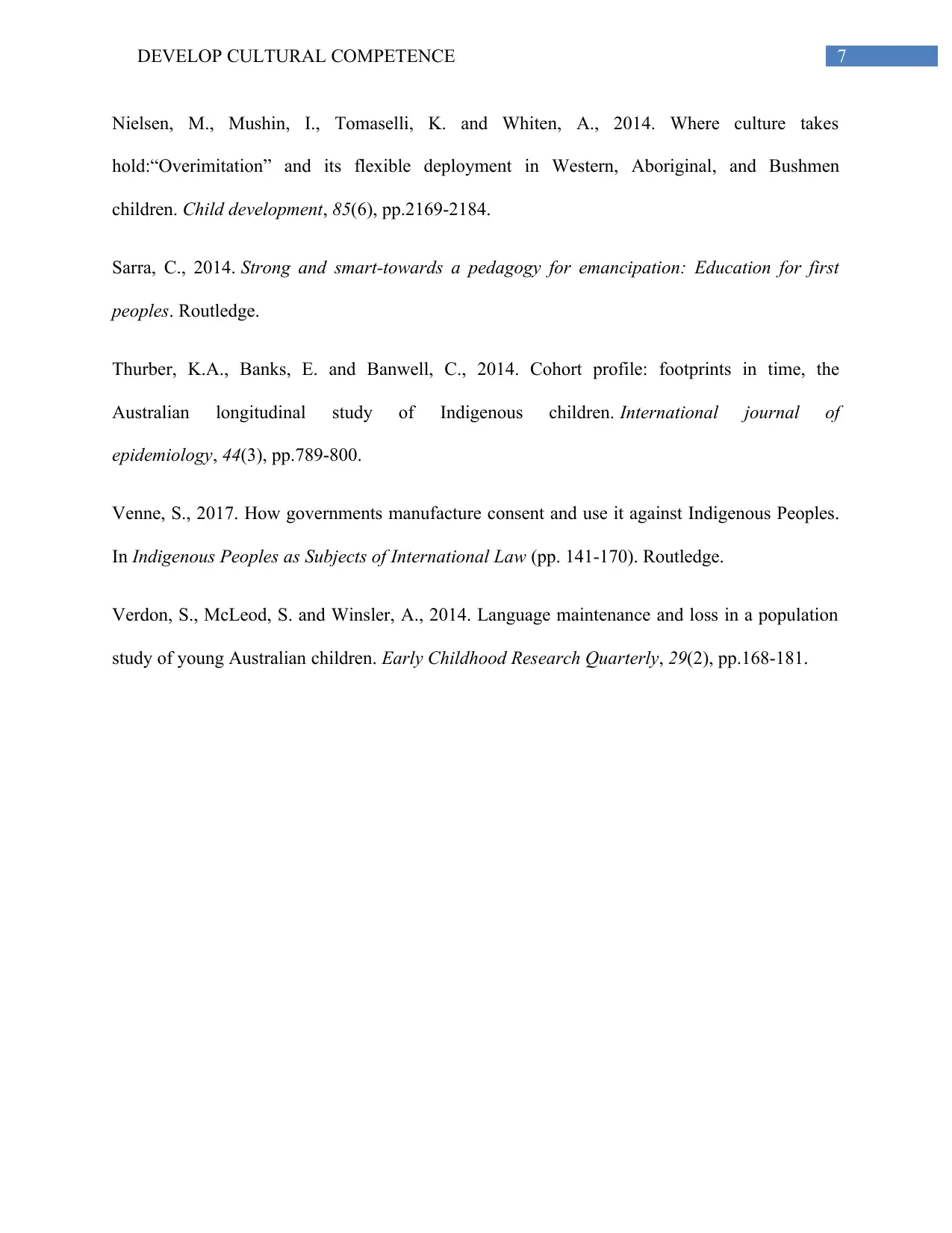
7DEVELOP CULTURAL COMPETENCE
Nielsen, M., Mushin, I., Tomaselli, K. and Whiten, A., 2014. Where culture takes
hold:“Overimitation” and its flexible deployment in Western, Aboriginal, and Bushmen
children. Child development, 85(6), pp.2169-2184.
Sarra, C., 2014. Strong and smart-towards a pedagogy for emancipation: Education for first
peoples. Routledge.
Thurber, K.A., Banks, E. and Banwell, C., 2014. Cohort profile: footprints in time, the
Australian longitudinal study of Indigenous children. International journal of
epidemiology, 44(3), pp.789-800.
Venne, S., 2017. How governments manufacture consent and use it against Indigenous Peoples.
In Indigenous Peoples as Subjects of International Law (pp. 141-170). Routledge.
Verdon, S., McLeod, S. and Winsler, A., 2014. Language maintenance and loss in a population
study of young Australian children. Early Childhood Research Quarterly, 29(2), pp.168-181.
Nielsen, M., Mushin, I., Tomaselli, K. and Whiten, A., 2014. Where culture takes
hold:“Overimitation” and its flexible deployment in Western, Aboriginal, and Bushmen
children. Child development, 85(6), pp.2169-2184.
Sarra, C., 2014. Strong and smart-towards a pedagogy for emancipation: Education for first
peoples. Routledge.
Thurber, K.A., Banks, E. and Banwell, C., 2014. Cohort profile: footprints in time, the
Australian longitudinal study of Indigenous children. International journal of
epidemiology, 44(3), pp.789-800.
Venne, S., 2017. How governments manufacture consent and use it against Indigenous Peoples.
In Indigenous Peoples as Subjects of International Law (pp. 141-170). Routledge.
Verdon, S., McLeod, S. and Winsler, A., 2014. Language maintenance and loss in a population
study of young Australian children. Early Childhood Research Quarterly, 29(2), pp.168-181.
1 out of 8
Related Documents
Your All-in-One AI-Powered Toolkit for Academic Success.
+13062052269
info@desklib.com
Available 24*7 on WhatsApp / Email
![[object Object]](/_next/static/media/star-bottom.7253800d.svg)
Unlock your academic potential
Copyright © 2020–2025 A2Z Services. All Rights Reserved. Developed and managed by ZUCOL.





